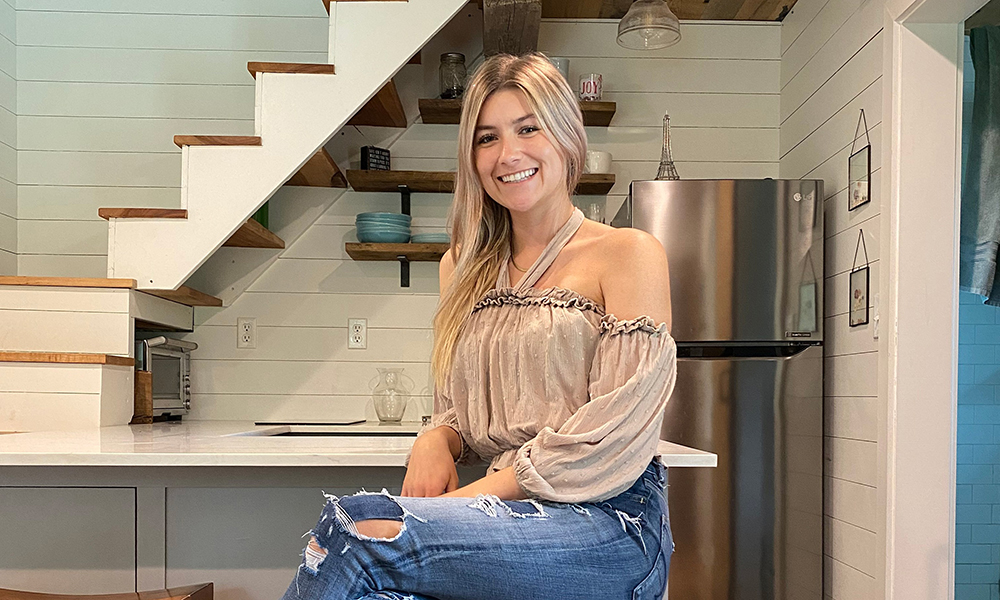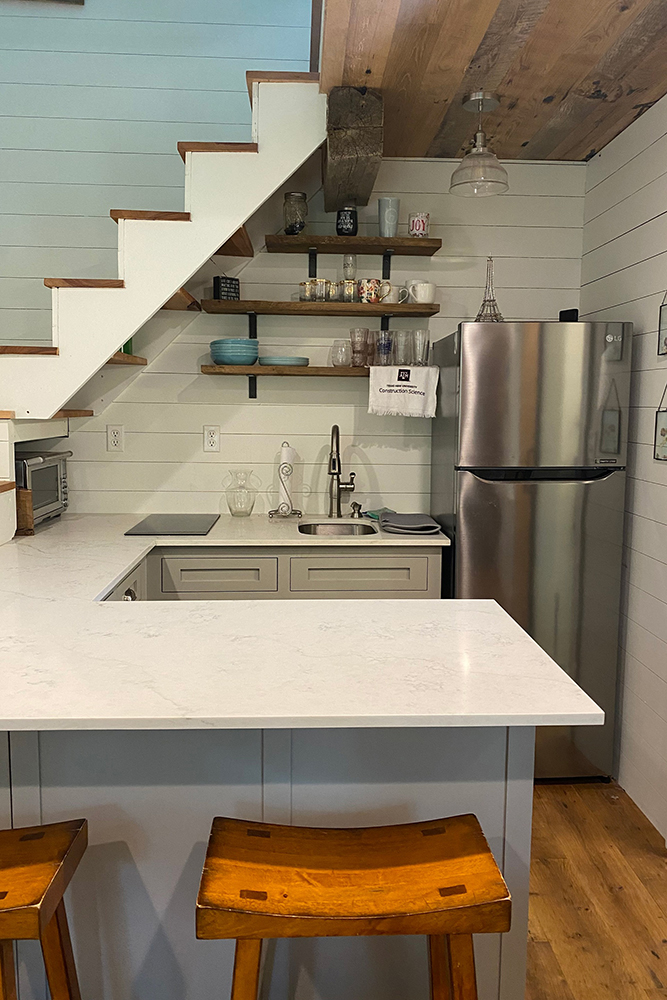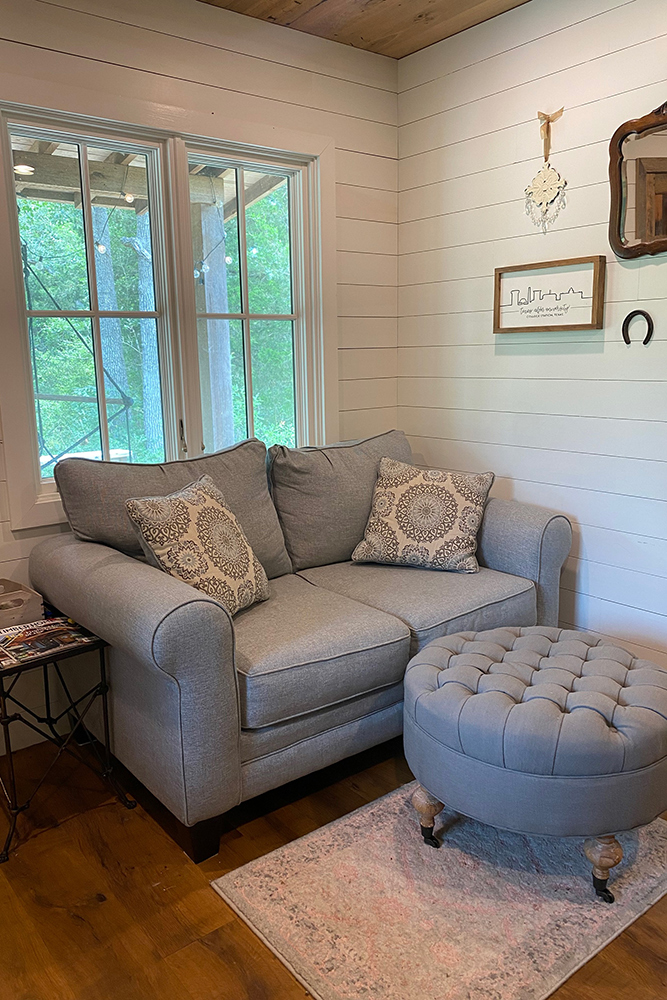
麦基恩·马特森回忆称,她在五年级的时候,想和朋友在父母位于美国得克萨斯州科利奇站的房子后院建一座堡垒。她们把她的秋千和滑梯推到一起,这时她的父亲走过来说:“为什么不真建一座堡垒呢?”她从未想过,这座面积为350平方英尺(约32.52平方米)的堡垒后来会成为她生活了五年的家,让她推迟了进入房地产市场的时间。
马特森大一的时候住在学校宿舍,之后父母给她两个选择:租房自己住,或者住在他们家后院的“小房子”里,只要她有需要,而且可以免缴房租。马特森对《财富》杂志表示:“这个选择就是,你能够自己住,但等你做好准备的时候可以搬出去。”回顾过去,她说:“我绝对不会改变这个选择。”

之后的五年,马特森一直住在后院的堡垒里,她在TikTok上发布与房地产和“蜗居”有关的内容,拥有接近10万粉丝。她说粉丝给她发来大量征求意见的信息,许多粉丝都是年轻人,在史无前例难以负担的房地产市场中,他们计划攒钱买房。有人甚至希望能够获得她的图纸,计划复制她的房子。
马特森节约的支出难以衡量,但据Zillow统计,在科利奇站,所有卧室和物业类型的房屋平均租金为1,800美元。她表示,她的朋友在共享公寓里的一间卧室,每个月的租金约为800美元,按五年来算相当于48,000美元。与马特森的小屋大小类似的工作室,租金接近1,200美元,这意味着她在五年内可能节省了高达72,000美元。马特森说,她每天可以吃妈妈做的家常菜,所以能够节省餐费支出。
马特森节省的支出不止这些。
她回忆称,她和父亲用大约八个月时间,将最初的堡垒改造成她的小家。除了大理石台面以外,他们自己动手完成了所有工作。父母为她支付了从施工到装修的所有费用(她说房子面积很小,因此装修费用并不高)。马特森表示,她认为建房成本不超过10万美元。

在这套小房子的帮助下,现在她可以购买自己的房子。
马特森表示,在成长过程中,她经常看到父亲自己动手打造各种物品。他拥有一家实木地板公司,马特森目前就在这家公司工作,年收入约6万美元。两个月前,她买下了一套三居双卫的房子,距离父母家只有10分钟车程。
马特森说:“对单身的我而言,这套房子已经很宽敞。”尤其是她曾经居住的房子面积只有350平方英尺(约32.52平方米),而现在的房子面积为1,500平方英尺(约139.35平方米),有三间卧室和两个卫生间。马特森表示,这套新房售价25万美元,首付3%(约7,500美元)。按照30年固定利率6.87%计算,她每个月的月供超过2,000美元,她认为这“太疯狂了”。据Zillow统计,科利奇站的平均房价略高于325,600美元,较去年上涨了6.4%。
马特森的经历并非特例。据皮尤研究中心(Pew Research Center)2022年的一份报告显示,过去五十年,有越来越多的成年人搬到父母家中居住。新冠疫情爆发后,2020年有超过一半29岁以下的美国人与父母生活在一起,创下自大萧条(Great Depression)以来的最高纪录,而且大多数人表示他们与父母生活在一起的目的是为了省钱。在新冠疫情期间的房地产热潮(Pandemic Housing Boom)中,全美房价上涨超过40%,而且个别市场的房价仍然在上涨,高房价导致许多年轻人被挤出了房地产市场,他们别无选择,只能与家人生活在一起。
这些年轻人通常住在父母的房子里,但像马特森这样的做法正在变得日益普遍。迈阿密大学(Miami University)的两位建筑学教授大力提倡马特森的住房类型,又被称为附属住宅单元(ADU)。亨廷顿比奇市曾经试图禁止附属住宅单元,但在遭到加利福尼亚州起诉后,这项禁令被废除。
马特森说:“如果我必须租房,我就绝对不可能有能力买房。我认为再过五年到七年,我也无力购房。”
马特森还表示,如果在房价上涨的同时,利率没有从新冠疫情期间的低位大幅上涨,情况可能就截然不同,因为她并不喜欢刚刚买下的房子,只是她认为这是一笔很好的投资。总之,她表示如果没有父母的扶持,她就绝对不可能有今天的结果。
马特森说:“我的父母小时候生活并不富足,他们白手起家,并出资建设了他们的房子。他们不想我再经历这样的事情,所以他们希望帮助我买房。”
马特森称,她很享受与父亲一起建造那栋小房子的过程,包括挑选涂料颜色和在Pinterest上寻找灵感等。马特森表示,小房子的楼下有一张双人沙发,工作台面两侧各有一张吧台椅,还有一台小冰箱。楼上是一张双人床,一个梳妆台,一个衣架,几乎没有储物空间。
当然,它之所以被称为小房子,正是因为它面积很小。在马特森的一条TikTok视频中可以看出,一个大包裹就占据了整个卧室和厨房的空间。马特森说,如果她某一天没有洗衣服,这意味着她的房子里就没有了下脚的地方,也无法做任何事情。总体上而言,她表示住在父母家后院“没有什么大不了的”,只是在这么小的房子里很难举行闺蜜聚会。

目前她正在搬家,她选择为新房购买二手家具来减少开支。她指出,蜗居的经历让她并不了解家具有多昂贵。虽然生活成本提高,但她表示她很高兴自己迈出了这一步。
马特森说:“我感觉,在24岁的年龄,在某个时刻我需要搬出父母的后院。”她表示,她告诉父母未来她会重新回到家庭大院居住,虽然她不再像以前那样靠近父母,但至少有家人在她身边,马特森非常喜欢这样的氛围。
至于她的小房子?它很快将迎来新租户:她22岁的弟弟夫妻二人。(财富中文网)
译者:刘进龙
审校:汪皓
麦基恩·马特森回忆称,她在五年级的时候,想和朋友在父母位于美国得克萨斯州科利奇站的房子后院建一座堡垒。她们把她的秋千和滑梯推到一起,这时她的父亲走过来说:“为什么不真建一座堡垒呢?”她从未想过,这座面积为350平方英尺(约32.52平方米)的堡垒后来会成为她生活了五年的家,让她推迟了进入房地产市场的时间。
马特森大一的时候住在学校宿舍,之后父母给她两个选择:租房自己住,或者住在他们家后院的“小房子”里,只要她有需要,而且可以免缴房租。马特森对《财富》杂志表示:“这个选择就是,你能够自己住,但等你做好准备的时候可以搬出去。”回顾过去,她说:“我绝对不会改变这个选择。”
之后的五年,马特森一直住在后院的堡垒里,她在TikTok上发布与房地产和“蜗居”有关的内容,拥有接近10万粉丝。她说粉丝给她发来大量征求意见的信息,许多粉丝都是年轻人,在史无前例难以负担的房地产市场中,他们计划攒钱买房。有人甚至希望能够获得她的图纸,计划复制她的房子。
马特森节约的支出难以衡量,但据Zillow统计,在科利奇站,所有卧室和物业类型的房屋平均租金为1,800美元。她表示,她的朋友在共享公寓里的一间卧室,每个月的租金约为800美元,按五年来算相当于48,000美元。与马特森的小屋大小类似的工作室,租金接近1,200美元,这意味着她在五年内可能节省了高达72,000美元。马特森说,她每天可以吃妈妈做的家常菜,所以能够节省餐费支出。
马特森节省的支出不止这些。
她回忆称,她和父亲用大约八个月时间,将最初的堡垒改造成她的小家。除了大理石台面以外,他们自己动手完成了所有工作。父母为她支付了从施工到装修的所有费用(她说房子面积很小,因此装修费用并不高)。马特森表示,她认为建房成本不超过10万美元。
在这套小房子的帮助下,现在她可以购买自己的房子。
马特森表示,在成长过程中,她经常看到父亲自己动手打造各种物品。他拥有一家实木地板公司,马特森目前就在这家公司工作,年收入约6万美元。两个月前,她买下了一套三居双卫的房子,距离父母家只有10分钟车程。
马特森说:“对单身的我而言,这套房子已经很宽敞。”尤其是她曾经居住的房子面积只有350平方英尺(约32.52平方米),而现在的房子面积为1,500平方英尺(约139.35平方米),有三间卧室和两个卫生间。马特森表示,这套新房售价25万美元,首付3%(约7,500美元)。按照30年固定利率6.87%计算,她每个月的月供超过2,000美元,她认为这“太疯狂了”。据Zillow统计,科利奇站的平均房价略高于325,600美元,较去年上涨了6.4%。
马特森的经历并非特例。据皮尤研究中心(Pew Research Center)2022年的一份报告显示,过去五十年,有越来越多的成年人搬到父母家中居住。新冠疫情爆发后,2020年有超过一半29岁以下的美国人与父母生活在一起,创下自大萧条(Great Depression)以来的最高纪录,而且大多数人表示他们与父母生活在一起的目的是为了省钱。在新冠疫情期间的房地产热潮(Pandemic Housing Boom)中,全美房价上涨超过40%,而且个别市场的房价仍然在上涨,高房价导致许多年轻人被挤出了房地产市场,他们别无选择,只能与家人生活在一起。
这些年轻人通常住在父母的房子里,但像马特森这样的做法正在变得日益普遍。迈阿密大学(Miami University)的两位建筑学教授大力提倡马特森的住房类型,又被称为附属住宅单元(ADU)。亨廷顿比奇市曾经试图禁止附属住宅单元,但在遭到加利福尼亚州起诉后,这项禁令被废除。
马特森说:“如果我必须租房,我就绝对不可能有能力买房。我认为再过五年到七年,我也无力购房。”
马特森还表示,如果在房价上涨的同时,利率没有从新冠疫情期间的低位大幅上涨,情况可能就截然不同,因为她并不喜欢刚刚买下的房子,只是她认为这是一笔很好的投资。总之,她表示如果没有父母的扶持,她就绝对不可能有今天的结果。
马特森说:“我的父母小时候生活并不富足,他们白手起家,并出资建设了他们的房子。他们不想我再经历这样的事情,所以他们希望帮助我买房。”
马特森称,她很享受与父亲一起建造那栋小房子的过程,包括挑选涂料颜色和在Pinterest上寻找灵感等。马特森表示,小房子的楼下有一张双人沙发,工作台面两侧各有一张吧台椅,还有一台小冰箱。楼上是一张双人床,一个梳妆台,一个衣架,几乎没有储物空间。
当然,它之所以被称为小房子,正是因为它面积很小。在马特森的一条TikTok视频中可以看出,一个大包裹就占据了整个卧室和厨房的空间。马特森说,如果她某一天没有洗衣服,这意味着她的房子里就没有了下脚的地方,也无法做任何事情。总体上而言,她表示住在父母家后院“没有什么大不了的”,只是在这么小的房子里很难举行闺蜜聚会。
目前她正在搬家,她选择为新房购买二手家具来减少开支。她指出,蜗居的经历让她并不了解家具有多昂贵。虽然生活成本提高,但她表示她很高兴自己迈出了这一步。
马特森说:“我感觉,在24岁的年龄,在某个时刻我需要搬出父母的后院。”她表示,她告诉父母未来她会重新回到家庭大院居住,虽然她不再像以前那样靠近父母,但至少有家人在她身边,马特森非常喜欢这样的氛围。
至于她的小房子?它很快将迎来新租户:她22岁的弟弟夫妻二人。(财富中文网)
译者:刘进龙
审校:汪皓
In fifth grade, Mckean Matson recalls, she and a friend wanted to build a fort in the backyard of her parents’ house in College Station, Texas. They pushed together her swing set and slide, but then her dad walked over to them and said, “Why don’t we actually build a fort?” Little did she know that the 350-square-foot result would later become her home for five years, delaying her journey into the housing market.
After living in a dorm during her freshman year of college, Matson’s parents gave her two options: She could either rent a place of her own or live in the “tiny house” in their backyard rent-free for as long as she needed. “This was kind of like, you can be on your own, but when you’re ready, you can move,” Matson told Fortune. Looking back now, she says, “I would not have changed it for the world.”
For the next five years, Matson lived in the backyard fort and gained close to 100,000 followers on TikTok, where she posted housing and “tiny living” content. She says she gets tons of messages from her followers asking for advice, and a lot of them are young adults looking to save money in a historically unaffordable housing market. Some even requested blueprints to replicate her house for themselves.
It’s hard to put a number on how much Matson’s saved, but the average rent for all bedrooms and property types in College Station is $1,800, per Zillow. She says her friends typically pay around $800 a month for a bedroom in a shared apartment—that equates to $48,000 over a five-year timespan. A studio comparable to Matson’s tiny house would be closer to $1,200, meaning she could have saved as much as $72,000 over those five years. She also eats her mom’s home-cooked meals every day, Matson says, so she’s saved on food, too.
The savings go a bit further than that, too.
She recalls that it took her and her dad around eight months to turn the fort into her tiny home. They did everything themselves, except for the granite countertops. Her parents paid for everything, from the construction costs to furnishing (she says there wasn’t much to furnish because it’s so small). Matson said she thinks it cost them less than $100,000.
And now it’s helped her buy her own house.
Growing up, Matson said she always saw her dad build everything by hand. He owns a hardwood flooring company, and that’s where she currently works, making around $60,000 a year. Just two months ago, she closed on a three-bedroom, two bathroom house that’s 10 minutes away from her parents.
“It’s a lot for one person,” she says, especially given she was living in a 350 square-foot house, and now she’s living in a 1,500-square-foot, three bedroom, two bathroom house. Matson says she put down 3% (roughly $7,500) on her $250,000 new home. With a 30-year fixed rate at 6.87%, her monthly mortgage payment is over $2,000, which she says is “insane.” The average home value in College Station is slightly above $325,600, an increase of 6.4% over the past year, per Zillow.
Matson’s experience isn’t an anomaly—adults have been increasingly moving in with their parents for the past five decades, according to a 2022 report from Pew Research Center. Following the onset of the pandemic, 2020 was the first time since the Great Depression that over half of all Americans under 29 were living with their parents, and most said their motivation was to save money. With home prices rising more than 40% on a national level during the Pandemic Housing Boom, and still rising in some markets, many young adults are getting priced out and have no choice but to live with their family.
Those younger people who live with their parents typically live inside their parents’ home, but arrangements like Matson’s are becoming more common. Two professors of architecture at Miami University have advocated for Matson’s style of housing, also known as an accessory dwelling unit, or ADU. Although, the City of Huntington Beach attempted to ban ADUs but rescinded that ban after the State of California filed a lawsuit against the city.
“If I had to rent, there’s no way I would have been able to purchase a home,” Matson said. “I don’t think I would [have been] able to purchase for another five to seven years.”
If interest rates hadn’t shot up from their pandemic lows along with home prices, it might’ve been a different story, Matson added, given she doesn’t absolutely love the home she just bought but figured it was a good investment. Either way, she says she wouldn’t be where she’s at today without her parents’ help.
“My parents didn’t grow up with a whole lot of money, they started from nothing and paid cash for their whole entire house to be built,” Matson said. “They didn’t want me to ever have to go through that, and so they wanted to set me up.”
Matson says she loved everything about the process of building the tiny house with her dad, including choosing the paint colors and scrolling through Pinterest for inspiration. Downstairs, Matson says, there’s a loveseat, two barstools across from her countertop, and a narrow fridge that’s made for tiny houses. Upstairs, there’s a full bed, a dresser, a clothing rack, and pretty much no storage space.
But of course it’s called a tiny house for a reason—it’s small. In one of Matson’s TikTok videos, you can see that one large package takes up the whole living room and kitchen, while Matson says that not putting away her laundry for one day means not being able to walk anywhere or do anything. Overall, she said it was “no big deal” to live in her parents’ backyard, although she said throwing girls’ nights was pretty challenging in such a small house.
Now that she’s in the process of moving, she’s cutting back on her spending while shopping for used furniture to fill her new house—tiny living didn’t prepare her for how expensive furniture would be, she says. Despite life getting more expensive, she says she’s glad she took this step.
“I felt like, I’m 24 years old, at some point, I need to move out of my parents backyard,” Matson said. Still, she added that she’s told her parents she would return to live in a family compound one day, where she might not be as physically close to them as her previous situation but would be at least surrounded by family—which Matson really enjoys.
As for her tiny house? It’s getting a new tenant soon: Her 22-year old brother, along with his wife.






